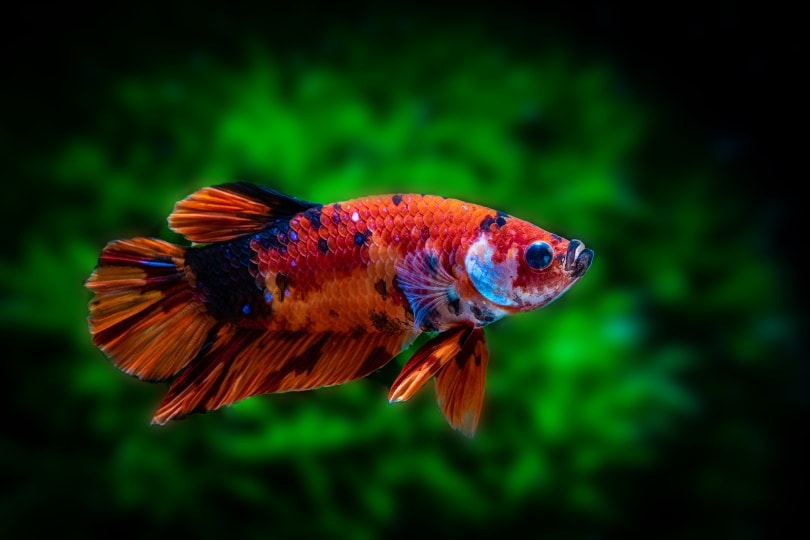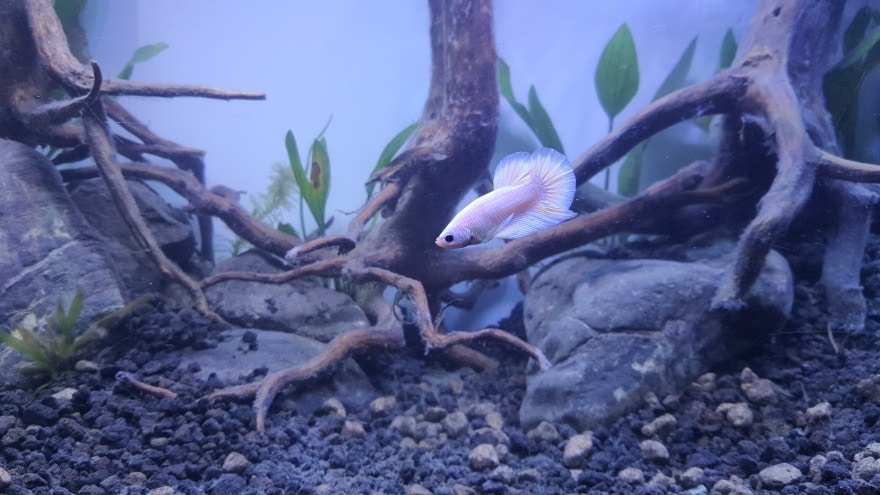Blue Betta Fish: Care Guide, Pictures, Lifespan & More

Updated on
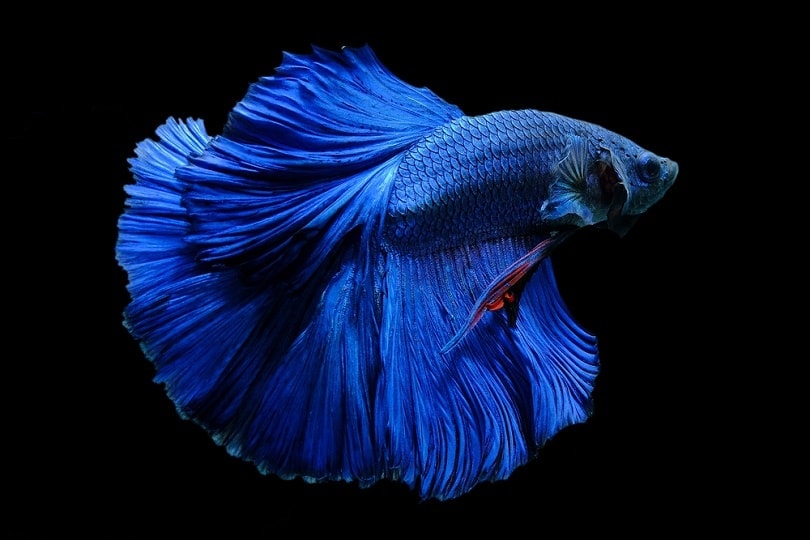
Click to Skip Ahead
It’s easy to understand the allure of the Blue Betta Fish. While not as showy as the more common Siamese Fighting Fish, it still shares the same flaring trait as a defense mechanism and courtship display. It is still raised for this purpose in its native Vietnam and Thailand.
However, it is less common in the aquarium trade, and it may be a challenge to find one. Nevertheless, the enthusiast will appreciate the Blue Betta Fish for its unique characteristics. Like other Bettas, it is easy to raise with the correct tank setup.
Quick Facts about Blue Betta Fish
| Species Name: | Betta smaragdina |
| Family: | Osphronemidae |
| Care Level: | Easy |
| Temperature: | 72-82℉ |
| Temperament: | Territorial |
| Color Form: | Male: Reddish-brown with bluish spots
Female: Brown with similar colored stripes |
| Lifespan: | Around three years |
| Size: | 2-3” L |
| Diet: | Carnivorous |
| Minimum Tank Size: | 3 gallons for a single fish |
| Tank Setup: | Artificial or live plants and a hiding place for cover |
| Compatibility: | Solitary or pairs |
Blue Betta Fish Overview
Little is known about the Blue Betta Fish in the wild. It lives in the inland wetlands and rice paddies of southeast Asia. The International Union for Conservation of Nature and Natural Resources lists the species as data deficient. However, its numbers are thought to be decreasing due to habitat encroachment and hybridization with other domestic species, including the Siamese Fighting Fish.
The Blue Betta Fish is a labyrinth species, referring to its unique respiratory organ that allows it to breathe air at the water’s surface. It makes evolutionary sense because low-oxygen conditions are common in its native habitat. It is a benthopelagic fish, meaning it can live in any water depth. It shares this trait with other popular aquarium species in its family, the Gouramis.
The Blue Betta Fish is raised primarily for fighting and not as an ornamental fish. It looks more like the species that you’d encounter in the wild, instead of the selectively bred fish that you see in pet stores. This coloration provides excellent camouflage. You may also see it called the Mekong Fighting Fish or the Emerald Green Betta.
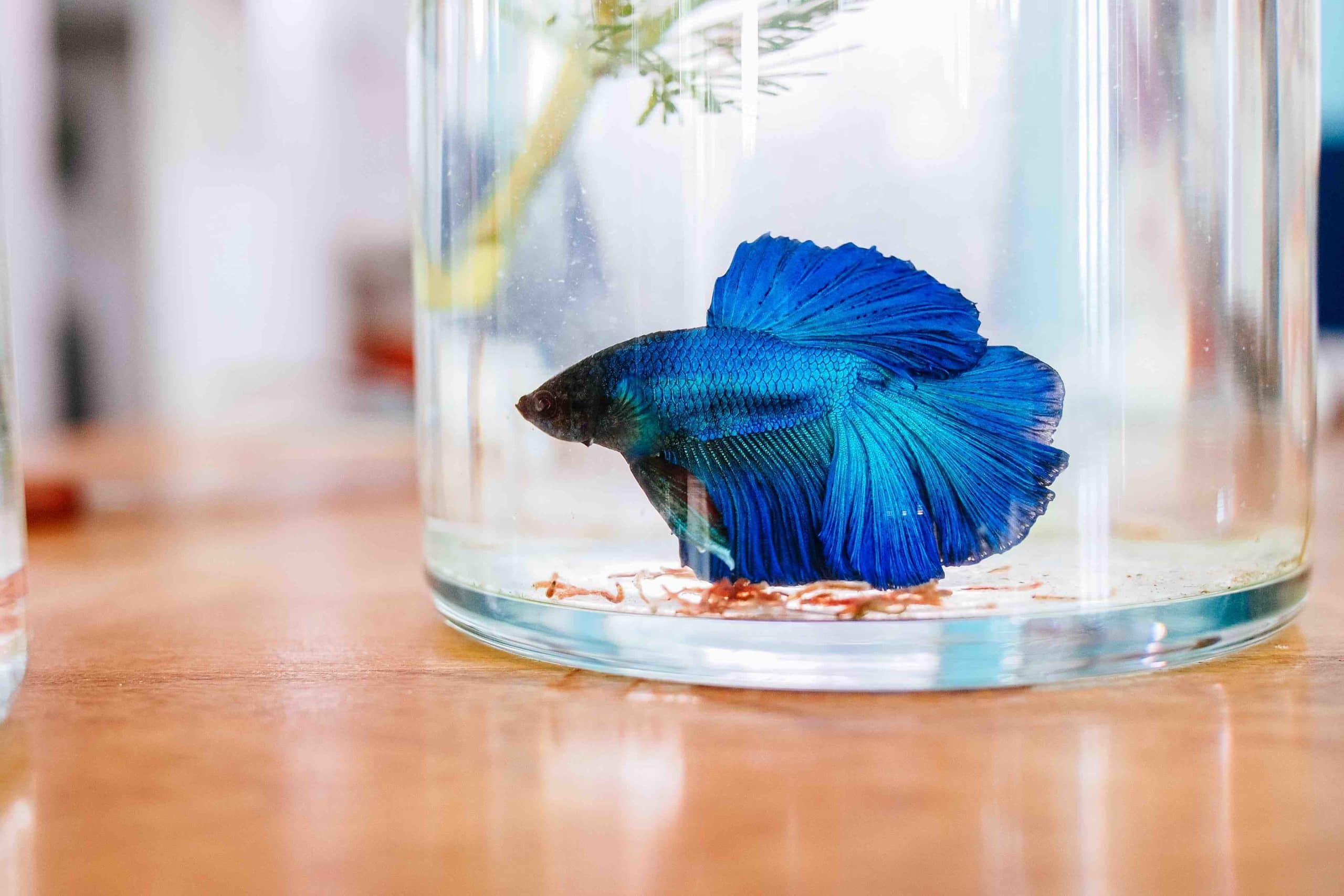
How Much Do Blue Betta Fish Cost?
Finding a Blue Betta Fish can be difficult. It’s essential to verify the species name. This one is the Betta smaragdina and not the more common Betta splendens. You’ll probably have to find a specimen online unless your local pet store can special order one for you. You can expect to pay anywhere from $20-$60 per fish.
On the other hand, a Siamese Fighting Fish will usually run about $3-$5. It’s worth mentioning that you may see these fish marked as Blue Bettas in reference to their coloration. Going by the species’ scientific name is the best way to ensure that you’re getting the right one.
Typical Behavior & Temperament
Unless it’s been selectively bred as a fighter, the Blue Betta Fish is a more docile species. Some people have kept them successfully as pairs, provided that there is enough space and cover. That is a stark contrast from the more commonplace Bettas that you find in pet stores.
The Blue Betta Fish also displays flaring behavior. It will do it to protect its territory from competing males by appearing larger. It will also act similarly during courtship, albeit without mouth locking or other aggressive moves.

Appearance & Varieties
The Blue Betta Fish lacks the finnage and showy coloration of other Bettas. However, it is striking on its own accord. The contrast between the brown and colored spots on its scales gives it an iridescent appearance. It has up to 26 anal soft rays and four to five anal rays on its body. Its caudal fin has a rounded edge that it can fan.
The female has the same body structure but is much drabber in color. That’s not uncommon in many animal species.
How to Take Care of Blue Betta Fish
The Blue Betta Fish, like others in its genus, stands out as a pet that is easy to care for, due in part to its labyrinth organ. That makes it more tolerant of less-than-ideal tank conditions, a desirable trait for survival in a variety of habitats with slow-moving water.
Habitat, Tank Conditions & Setup
The correct setup will go a long way toward ensuring the health and good quality of life for your Blue Betta Fish. Your goals are to create an environment that replicates its native habitat while staying as stable as possible. Drastic changes can stress your fish and make them more vulnerable to disease.
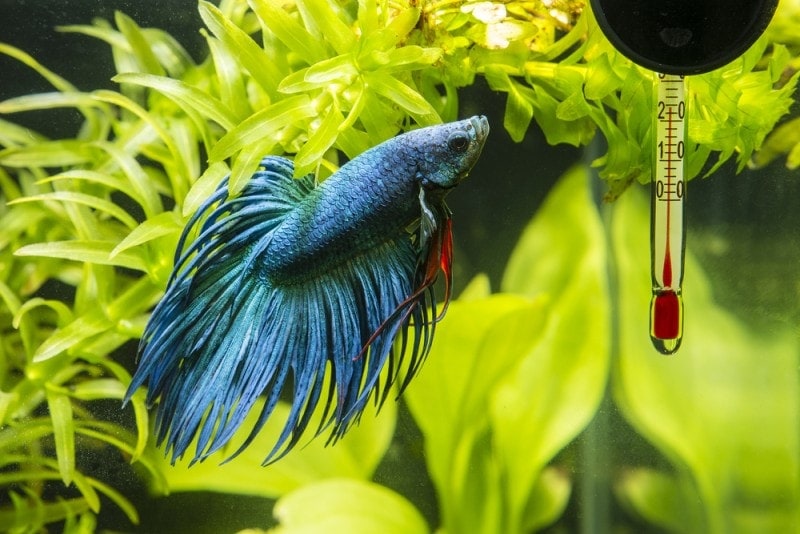
Tank Setup
If you plan on keeping just one fish, a 3-gallon tank is suitable. While you may see Bettas in bowls, we strongly urge you to opt for the larger aquarium. The conditions will stay more stable, and you’ll have less maintenance on your hands. If you opt for a pair, we suggest going with a 10-gallon tank. That’ll make the transition easier if the two breed successfully.
The rest of the setup is similar to what you’d provide for other aquarium fish. It should have a 3-inch layer of substrate for biological filtration. You can add either live or artificial plants. Blue Betta Fish won’t dig them up or eat them. Floating plants are something to consider because Bettas will often swim under them for cover.
Despite the Blue Betta Fish’s tolerance, we recommend adding a filter to your tank. It will break the surface of the water to facilitate gas exchange and get more dissolved oxygen into the water. You should also do 25% water changes at least once a month to keep the conditions healthy for your fish.
Water Chemistry
The proper water chemistry is vital for any fish. The Blue Betta is no exception. We suggest monitoring it with testing at least every 2 weeks or more often if the tank is small. These fish prefer slightly acidic conditions around 6.8-7.5 pH. Ideally, ammonia, nitrites, and nitrates are 0. However, they can handle elevated nitrates up to 40 ppm.
The Blue Betta Fish does best with a general hardness of at least 30 ppm, particularly if you have live plants in your tank. Likewise, a carbonate hardness of 80-120 ppm will help keep the pH level stable.
Lighting and Heating
The Blue Betta Fish does well with at least 12 hours of UV light per day. That’s something to keep in mind when deciding where to place your tank. The other consideration is heat. The light won’t give off enough to keep the conditions stable. Instead, you can put a submersible heater in the tank to keep it within its preferred range of 72-82℉.
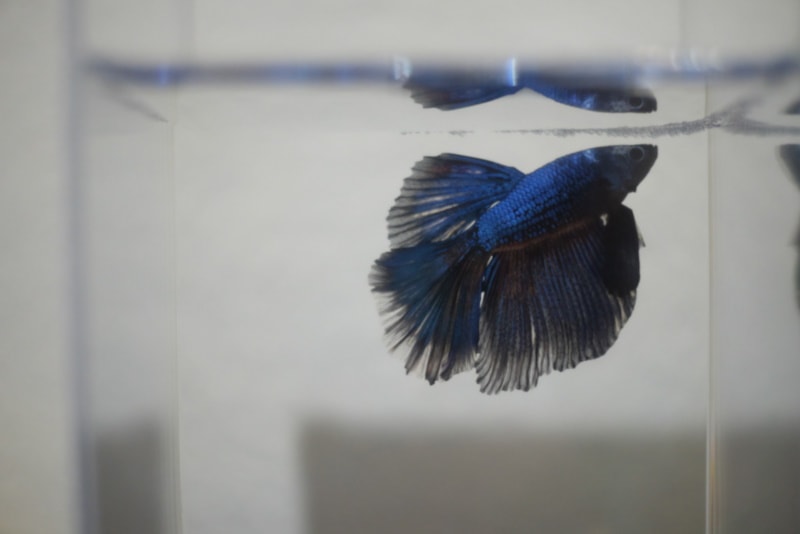
Are Blue Betta Fish Good Tank Mates?
The Blue Betta Fish will do best on its own or in pairs. While it isn’t as vulnerable to nipping as its showy cousins, it still isn’t as mobile as faster-moving fish. If you’d like to add other species to your aquarium, we suggest sticking with small, docile schooling fish, such as Zebra Danios and Tetras. Just make sure there is enough cover.
You should never put aggressive fish, such as Tiger Barbs, in a tank with Blue Betta Fish, if just for the cost of replacing it if it gets hurt. Of course, you should only have one male per tank.
What to Feed Your Blue Betta Fish
In the wild, the Blue Betta Fish, being a carnivore, would feed on insects and invertebrates. You can replicate its diet in your aquarium with freeze-dried brine shrimp or other species. Floating pellets are an excellent choice because these fish often hang around the surface of the water. You can also offer live foods, such as plankton. Make sure to remove any uneaten food promptly.
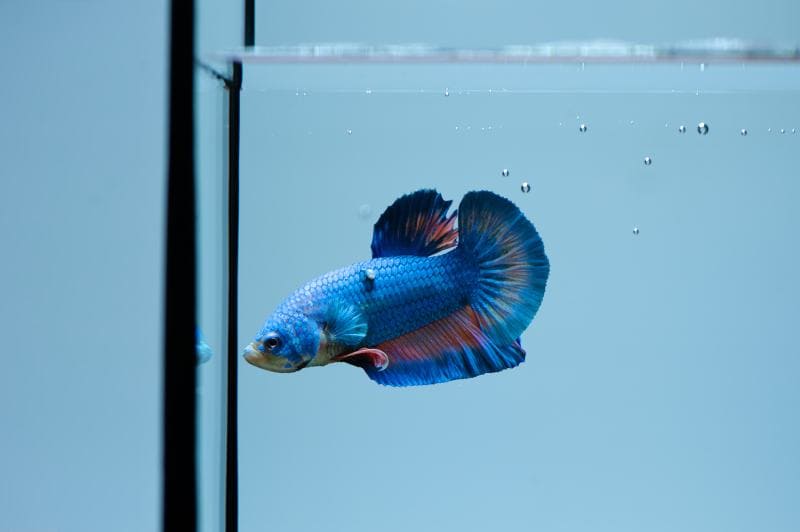
Keeping Your Blue Betta Fish Healthy
The Blue Betta Fish is easygoing as far as pets are concerned. They’re easy to take care of, without many other demands. Stable conditions are the best way to ensure that they stay healthy. That’s what makes regular water changes so vital. We also suggest adding décor, such as driftwood, to your tank to provide mental stimulation for this intelligent fish.
Breeding
The male Blue Betta Fish is unique in that it uses its flaring behavior during courtship. When the female is ready to spawn, the male will create a bubble nest at the surface of the water. That’s another reason that you should have floating plants.
When the female releases eggs, the male takes them up to the protective cover of the bubble nest. It’ll even fetch the ones that don’t make it. Both the male and female will take care of the young Bettas, or fry. However, that’s only short-lived. Like many other species, the male Blue Betta Fish will eventually eat the young. You should either remove the fish or put up a barrier to protect them.
Are Blue Betta Fish Suitable for Your Aquarium?
The Blue Betta Fish might not be the most common species in the aquarium trade, but it is a striking fish that will make a welcome addition to an enthusiast’s collection. The care is similar to others of its genus. The only glaring difference is the availability and cost of the fish. If you decide to get one, it’s best to give it its own setup with another of its kind or a few peaceful tankmates.
See also:
Featured Image Credit: Jeravano, Shutterstock




